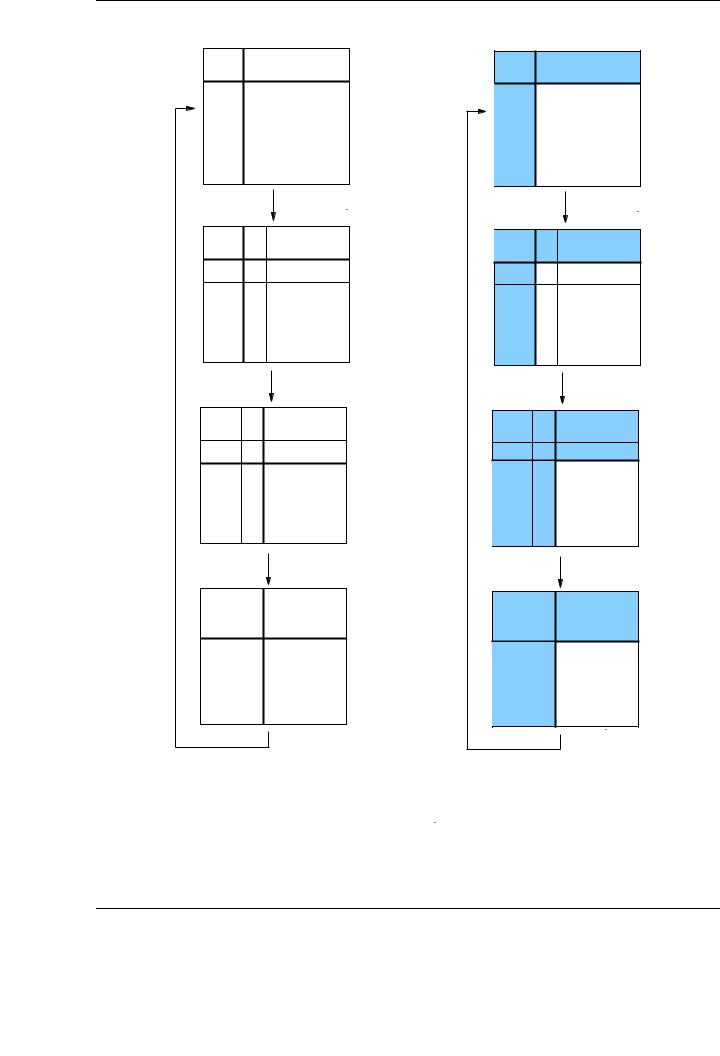
- •Matrix computations on systems equipped with GPUs
- •Introduction
- •The evolution of hardware for High Performance Computing
- •The programmability issue on novel graphics architectures
- •About this document. Motivation and structure
- •Motivation and goals
- •Structure of the document
- •Description of the systems used in the experimental study
- •Performance metrics
- •Hardware description
- •Software description
- •The FLAME algorithmic notation
- •The architecture of modern graphics processors
- •The graphics pipeline
- •Programmable pipeline stages
- •The Nvidia G80 as an example of the CUDA architecture
- •The architecture of modern graphics processors
- •General architecture overview. Nvidia Tesla
- •Memory subsystem
- •The GPU as a part of a hybrid system
- •Arithmetic precision. Accuracy and performance
- •Present and future of GPU architectures
- •Conclusions and implications on GPU computing
- •BLAS on single-GPU architectures
- •BLAS: Basic Linear Algebra Subprograms
- •BLAS levels
- •Naming conventions
- •Storage schemes
- •BLAS on Graphics Processors: NVIDIA CUBLAS
- •Evaluation of the performance of NVIDIA CUBLAS
- •Improvements in the performance of Level-3 NVIDIA CUBLAS
- •gemm-based programming for the Level-3 BLAS
- •Systematic development and evaluation of algorithmic variants
- •Experimental results
- •Impact of the block size
- •Performance results for rectangular matrices
- •Performance results for double precision data
- •Padding
- •Conclusions
- •LAPACK-level routines on single-GPU architectures
- •LAPACK: Linear Algebra PACKage
- •LAPACK and BLAS
- •Naming conventions
- •Storage schemes and arguments
- •LAPACK routines and organization
- •Cholesky factorization
- •Scalar algorithm for the Cholesky factorization
- •Blocked algorithm for the Cholesky factorization
- •Computing the Cholesky factorization on the GPU
- •Basic implementations. Unblocked and blocked versions
- •Padding
- •Hybrid implementation
- •LU factorization
- •Scalar algorithm for the LU factorization
- •Blocked algorithm for the LU factorization
- •LU factorization with partial pivoting
- •Computing the LU factorization with partial pivoting on the GPU
- •Basic implementations. Unblocked and blocked versions
- •Padding and hybrid algorithm
- •Reduction to tridiagonal form on the graphics processor
- •The symmetric eigenvalue problem
- •Reduction to tridiagonal form. The LAPACK approach
- •Reduction to tridiagonal form. The SBR approach
- •Experimental Results
- •Conclusions
- •Matrix computations on multi-GPU systems
- •Linear algebra computation on multi-GPU systems
- •Programming model and runtime. Performance considerations
- •Programming model
- •Transfer management and spatial assignation
- •Experimental results
- •Impact of the block size
- •Number of data transfers
- •Performance and scalability
- •Impact of data distribution
- •Conclusions
- •Matrix computations on clusters of GPUs
- •Parallel computing memory architectures
- •Shared memory architectures
- •Distributed memory and hybrid architectures
- •Accelerated hybrid architectures
- •Parallel programming models. Message-passing and MPI
- •ScaLAPACK
- •PLAPACK
- •Elemental
- •Description of the PLAPACK infrastructure
- •Layered approach of PLAPACK
- •Usage of the PLAPACK infrastructure. Practical cases
- •Porting PLAPACK to clusters of GPUs
- •Experimental results
- •Conclusions
- •Conclusions
- •Conclusions and main contributions
- •Contributions for systems with one GPU
- •Contributions for clusters of GPUs
- •Related publications
- •Publications directly related with the thesis topics
- •Publications indirectly related with the thesis topics
- •Other publications
- •Open research lines
- •FLAME algorithms for the BLAS-3 routines

1.4. THE FLAME ALGORITHMIC NOTATION
|
|
PECO |
TESLA2 |
Type of machine |
|
Cluster of SMP |
SMP |
Number of nodes |
|
4 |
- |
|
|
|
|
|
|
|
|
Processor |
|
Intel Xeon E5520 |
Intel Xeon E5440 |
Processor codename |
|
Nehalem |
Harpertown |
|
|
|
|
Frequency |
|
2.27 Ghz |
2.83 Ghz |
Number of cores |
|
8 |
8 |
|
|
|
|
Available memory |
|
24 Gbytes DDR2 |
16 Gbytes DDR2 |
|
|
|
|
Interconnection network |
|
Infiniband QDR |
- |
|
|
|
|
GPU |
|
NVIDIA Tesla C1060 |
NVIDIA Tesla S1070 |
|
|
|
|
Interconnection bus |
|
PCIExpress 2.0 |
PCIExpress 2.0 |
Available memory |
|
4 Gbytes DDR3 |
16 Gbytes DDR3 |
|
|
|
|
Table 1.1: Description of the hardware platforms used in the experiments. The features of PECO are referred to each node of the cluster.
node of PECO. This machine will be the base for the experimental process of the multi-GPU implementations described in Chapter 5.
LONGHORN is a distributed-memory machine composed of 256 nodes based on the Intel Xeon technology. It presents four Intel Xeon 5540 (Nehalem) Quadcore processors per node running at 2.13 Ghz, with 48 Gbytes of DDR2 RAM memory each. Attached to the PCIExpress 2.0 bus of each node, there are two NVIDIA Quadro FX5800 GPUs with 4 Gbytes of DDR3 RAM memory. Nodes are interconnected using a fast QDR Infiniband network. This machine will be the testbed for the experimental stage in Chapter 6.
A more detailed description of the hardware can be found in Tables 1.1 and 1.2. In the selection of those machines, we have chosen those graphics processors and general-purpose processors as close in generational time as possible. This makes it possible to fairly compare single-GPU, multi-GPU and distributed-memory implementations with minimal deviations.
1.3.3.Software description
The software elements used in our work can be divided in two di erent groups. The GPU-related software is selected to be as homogeneous as possible to allow a fair comparison of the di erent platforms. Note that many of the routines presented in the document employ the BLAS implementation (NVIDIA CUBLAS). This implies that experimental results will ultimately depend on the underlying BLAS performance. However, each technique introduced in this research is independent of the specific BLAS implementation. Thus, we expect that when future releases of the NVIDIA CUBLAS library (or other alternative implementations of the BLAS) appear, the performance attained by our codes will be improved in the same degree as the new BLAS implementation. In all the experiments, we employed CUDA 2.3 and CUBLAS 2.3. MKL 10.1 has been used for the CPU executions of the codes in all machines.
1.4.The FLAME algorithmic notation
Many of the algorithms included in this document are expressed using a notation developed by the FLAME (Formal Linear Algebra Methods Environment) project. The main contribution of
13

CHAPTER 1. MATRIX COMPUTATIONS ON SYSTEMS EQUIPPED WITH GPUS
|
|
Per Node |
|
Per System |
Type of machine |
|
Cluster of SMP |
||
Number of nodes |
|
|
256 |
|
|
|
|
|
|
|
|
|
|
|
Processor |
|
Intel Xeon E5440 |
||
Processor codename |
|
Nehalem |
||
|
|
|
|
|
Frequency |
|
2.53 GHz |
||
Number of cores |
|
8 |
|
2,048 |
|
|
|
|
|
Available memory |
|
48 Gbytes |
|
13.5 Tbytes |
|
|
|
||
Interconnection network |
|
Infiniband QDR |
||
|
|
|
||
Graphics system |
|
128 NVIDIA Quadro Plex S4s |
||
|
|
|
|
|
GPU |
|
2 x NVIDIA Quadro FX5800 |
|
512 x NVIDIA Quadro FX5800 |
Interconnection bus |
|
PCI Express 2.0 |
||
|
|
|
|
|
Available memory |
|
8 Gbytes DDR3 |
|
2 Tbytes DDR3 |
|
|
|
|
|
|
|
|
|
|
Peak performance (SP) |
|
161.6 GFLOPS |
|
41.40 TFLOPS |
|
|
|
|
|
Peak performance (DP) |
|
80.8 GFLOPS |
|
20.70 TFLOPS |
Table 1.2: Detailed features of the LONGHORN cluster. Peak performance data only consider the raw performance delivered by the CPUs in the cluster, excluding the GPUs.
this project is the creation of a new methodology for the formal derivation of algorithms for linear algebra operations. In addition to this methodology, FLAME o ers a set of programming interfaces (APIs) to easily transform algorithm into code, and a notation to specify linear algebra algorithms. The main advantages of the FLAME notation are its simplicity, concretion and high abstraction level.
Figure 1.2 shows an algorithm using the FLAME notation for the decomposition of a matrix A into the product of two triangular factors, A = LU, with L being unit lower triangular (all diagonal elements equal 1) and U upper triangular. In this case, the elements of the resulting matrices L and U are stored overwriting the elements of A.
Initially the matrix A is partitioned into four blocks AT L, AT R, ABL, ABR, with the first three blocks being empty. Thus, before the first iteration of the algorithm, the block ABR contains all the elements of the matrix A.
For each iteration, the block ABR is divided, as shown in Figure 1.3, into four blocks: α11, a21, aT12 and A22, and thus being partitioned into 9 blocks). The elements of the L and U factors corresponding to the first three blocks are calculated during the current iteration, while A22 is updated accordingly. At the end of the current iteration, the 2 × 2 partition of the matrix is recovered, and ABR corresponds to the sub-matrix A22. Proceeding in this manner, the operations of the next iteration will be applied again to the recently created block ABR.
The algorithm is completed when the block ABR is empty, that is, when the number of rows of the block AT L equals the number of rows of the whole input matrix A and, therefore, AT L = A. Using the FLAME notation, the loop iterates while m(AT L) < m(A), where m(·) is the number of rows of a matrix (or the number of elements of a column vector). Similarly, n(·) will be used to denote the number of columns in a matrix (or the number of elements in a row vector).
It is quite usual to formulate an algorithm by blocks for a given operation. These algorithms are easily illustrated using the same notation, in which it is only necessary to include an additional parameter: the algorithmic block size. This is a scalar dimension that determines the value of the blocks involved in the algorithms and is usually denoted by the character b.
14

1.4. THE FLAME ALGORITHMIC NOTATION
Algorithm: A := LU(A)
Partition |
A → |
|
AT L |
|
|
|
AT R |
|
! |
|
|
|
|
|
||||||
|
|
|
|
|
|
|
|
|
|
|
|
|||||||||
|
ABL |
|
|
ABR |
|
|
|
|
|
|||||||||||
|
where AT L is 0 × 0 |
|
|
|
|
|
|
|
|
|
|
|
|
|||||||
while |
m(AT L) < m(A) |
do |
|
|
|
|
|
|
|
|||||||||||
|
Repartition |
|
|
|
|
|
|
|
|
|
|
|
|
|
|
|
||||
|
|
AT L |
|
AT R |
|
! → |
|
|
|
A00 |
|
a01 |
|
A02 |
|
|
||||
|
|
|
|
|
|
|
|
|
||||||||||||
|
|
|
|
|
|
|
|
|||||||||||||
|
|
|
|
|
|
|
|
|
|
|
|
|
|
|||||||
|
|
|
|
|
|
|
T |
|
|
|
|
T |
|
|||||||
|
|
ABL |
|
ABR |
|
|
|
|
a10 |
|
α11 |
|
a12 |
|
|
|||||
|
|
|
|
|
|
|
|
|
|
A20 |
|
a21 |
|
A22 |
|
|||||
|
|
|
|
|
|
|
|
|
|
|
|
|
|
|
|
|
|
|||
|
where |
|
α11 is a |
scalar |
|
|
|
|
|
|
|
|
||||||||
|
|
|
|
|
|
|
|
|
||||||||||||
|
|
|
|
|
|
|
|
|
|
|
|
|
|
|||||||
|
α11 |
:= |
|
v11 = α11 |
|
|
|
|
|
|
|
|
|
|
|
|
||||
|
a12T |
:= |
|
v12T = a12T |
|
|
|
|
|
|
|
|
|
|
|
|
||||
|
a21 |
:= |
|
l21 = a21/v11 |
|
|
|
|
|
|
|
|
|
|||||||
|
A22 |
:= |
|
A22 − l21 · v12T |
|
|
|
|
|
|
|
|
|
|||||||
|
|
|
|
|
|
|
|
|
|
|
|
|
|
|
|
|
||||
|
Continue with |
|
|
|
|
|
|
|
|
|
|
|
|
|
|
|
||||
|
|
AT L |
|
AT R |
|
|
|
|
|
|
A00 |
|
a01 |
|
|
A02 |
|
|
||
|
|
|
|
|
|
|
|
|
|
|
|
|
|
|||||||
|
|
|
|
|
|
|
|
|
|
|
|
|
||||||||
|
|
|
|
|
|
|
|
|
|
|
|
|
|
|
|
|
|
|||
|
|
|
|
! ← |
a10T |
|
α11 |
|
|
a12T |
|
|||||||||
|
|
|
|
|
|
|
|
|
|
|||||||||||
|
|
ABL |
|
ABR |
|
|
|
|||||||||||||
|
|
|
|
|
A20 |
|
a21 |
|
|
A22 |
|
|||||||||
|
|
|
|
|
|
|
|
|
|
|
|
|
|
|
|
|
|
|||
endwhile |
|
|
|
|
|
|
|
|
|
|
|
|
|
|
|
|||||
|
|
|
|
|
|
|
|
|
|
|
|
|||||||||
Figure 1.2: Algorithm for the LU factorizaction without pivoting using the FLAME notation.
15

CHAPTER 1. MATRIX COMPUTATIONS ON SYSTEMS EQUIPPED WITH GPUS
AT L AT R
ABL ABR
A00
α11 aT12
a21 A22
A00
α11 aT12
a21 A22
AT L AT R
ABL ABR
CALCULAT ED
ED |
|
P artially |
LAT |
|
|
|
updated |
|
CALCU |
|
|
|
|
CALCULAT ED |
ED |
|
|
LAT |
|
P artially |
|
updated |
|
CALCU |
|
|
|
|
|
|
|
CALCULAT ED |
ED |
|
|
LAT |
|
P artially |
|
|
|
CALCU |
|
updated |
|
|
|
|
|
CALCULAT ED |
|
ED |
P artially |
|
LAT |
|
|
updated |
|
|
CALCU |
|
|
|
Figure 1.3: Matrix partitions applied to matrix A during the algorithm of Figure 1.2.
16

1.4. THE FLAME ALGORITHMIC NOTATION
The FLAME notation is useful as it allows the algorithms to be expressed with a high level of abstraction. These algorithms have to be transformed into a routine or implementation, with a higher level of concretion. For example, the algorithm in Figure 1.2 does not specify how the operations inside the loop are implemented. Thus, the operation A21 := A21/v11 could be executed by an invocation to the routine SCAL in BLAS-1; alternatively, this operation could be calculated using a simple loop. Therefore, it is important to distinguish between algorithm and routine. In the following chapters we will show how the FLAME/C API allows an almost straightforward translation of the algorithms into high performance C codes.
17

CHAPTER 1. MATRIX COMPUTATIONS ON SYSTEMS EQUIPPED WITH GPUS
18
